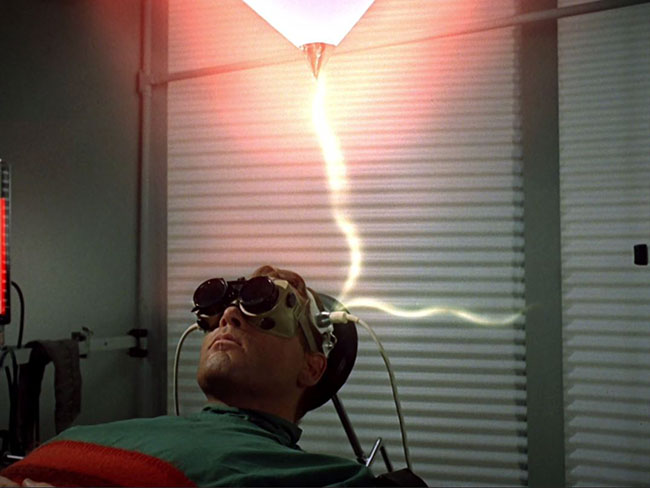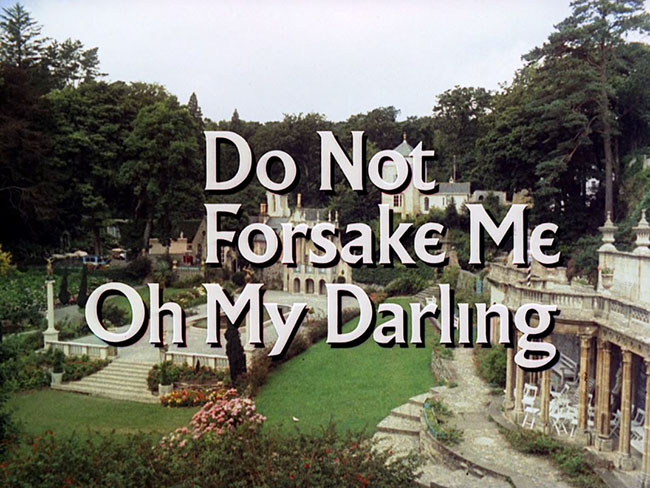DO NOT FORSAKE ME OH MY DARLING First UK Broadcast: December 22, 1967 [episode #13 in transmission order] | Written by Vincent Tilsley | Directed by Pat Jackson
SYNOPSIS
Both British intelligence and the Village are hunting for Dr. Seltzman (Hugo Schuster), a brilliant scientist who has invented a “thought transference” machine that can swap the minds of two individuals. Because No.6 was the last one to make contact with Seltzman, the Village wants to send him after the man. No.2 (Clifford Evans, Kiss of the Vampire) brings in the Colonel (Nigel Stock, The Great Escape) and uses such a machine to put his mind into the body of No.6 and vice versa. But No.2 doesn’t know how to reverse the process: No.6 will have to track down Seltzman to uncover it. No.6 undergoes therapy in the “Amnesia Room” to purge memories of the Village, leaving him only with his mission. And so the Prisoner – in the shape of the Colonel – awakens in his old flat back in London, unaware that a full year has passed. He’s set straight by his fiancée Janet (Zena Walker), but she doesn’t believe he’s truly the man she was engaged to a year ago. No.6 sets out for his old office and tries to tell his incredible story, but even after giving his code name (ZM73), Sir Charles Portland (John Wentworth), Janet’s father, says only that he’ll be having him followed to determine what he’s up to. No.6 picks up slides of Seltzman’s which he had dropped off a year ago, and when he overlays select ones in a projector, a secret message is revealed: “Kandersfeld, Austria.” He travels to Austria and finds Seltzman working as a barber, then struggles to convince him that he’s his old colleague. A Village agent who’s been following No.6 – a hearse driver, like the one who abducted him a year ago – gasses them both and has them returned to the Village. Seltzman reluctantly agrees to perform the experimental reversal process, and No.6’s mind is transferred back to his body. But only after the Colonel departs by helicopter is it obvious that Seltzman has swapped minds with him; he’s escaped the Village in the Colonel’s body.
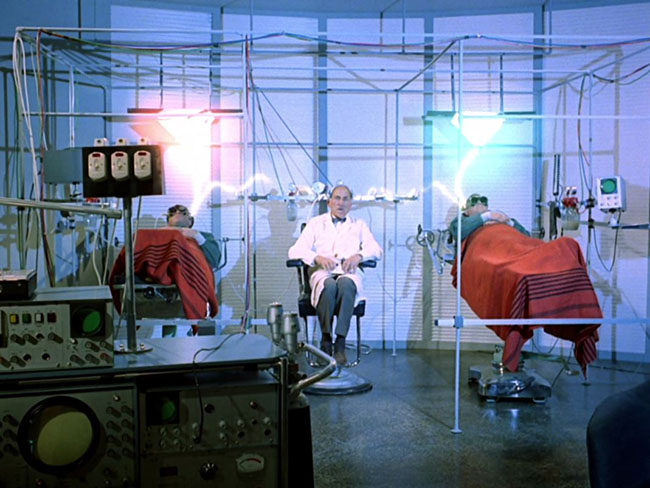
Seltzman (Hugo Schuster) performs the mind transference reversal process on No.6 and the Colonel (Nigel Stock).
OBSERVATIONS
After completing the first thirteen episodes of The Prisoner‘s production schedule, Patrick McGoohan had to depart for the U.S. to shoot his role in what would become Howard Hughes’ favorite movie, Ice Station Zebra (1968). But Everyman Films Ltd. had committed to producing four more episodes, and production couldn’t be delayed (already it was taking longer than expected to deliver Prisoner episodes to ITC). Vincent Tilsley, who had delivered the wonderful script for “The Chimes of Big Ben,” was handed the unenviable task of writing a Prisoner episode that would not require McGoohan. Further, he was asked if it could take place outside of the Village, in a cost-saving effort. As he recalled in Don’t Knock Yourself Out, “The only thing I could think of was this mind swap thing. I didn’t like it from the start. I was writing a script I didn’t believe in, and that’s a nasty thing to do. I’ve never been married to somebody I hated, but I should think that it’s much the same feeling…you don’t want to be in this relationship.” His script was called “Face Unknown,” and his premise would involve another actor – Nigel Stock, as it happened – playing No.6 for the bulk of the running time. McGoohan was only needed minimally: for a voice-over and an appearance at the end. (In the first draft of “Face Unknown,” he wasn’t physically needed at all.) When McGoohan returned, he was dissatisfied with the rough cut and made further changes, including the title, now named after the popular song from High Noon. Notably, the second half of the opening credits are altered: against a new soundtrack we see aerial shots of Portmeirion as the helicopter carrying the Colonel slowly descends. The episode is also unique in that it contains a pre-credits sequence explaining that Sir Charles is looking for the missing Dr. Seltzman.
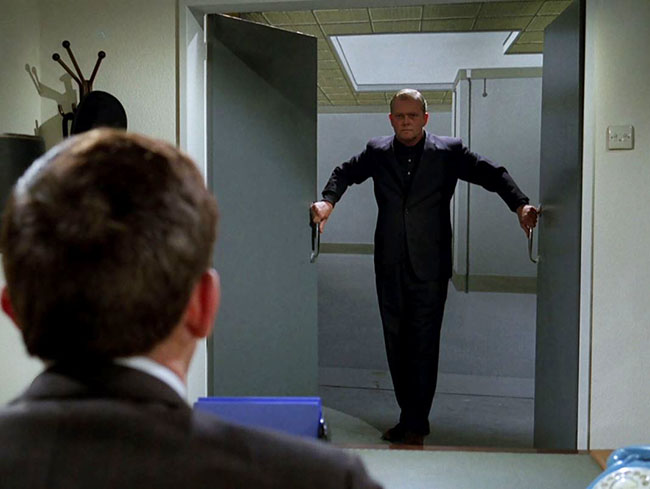
No.6, in the body of the Colonel (Nigel Stock), returns to the office where he resigned.
This is the most disposable episode of The Prisoner – a victim of circumstance perhaps, but disposable nonetheless. One can feel McGoohan’s absence not just physically but in the story itself, which commits the cardinal sin of actually giving the Prisoner a love interest in the form of his fiancée Janet. But unlike “Many Happy Returns,” “Do Not Forsake Me Oh My Darling” presents a more complete portrait of his life before becoming No.6, even if it contradicts that episode: why didn’t No.6 visit Janet the first time he got free? (Well, because Tilsley didn’t write that episode, that’s why.) We meet another of his superiors, Sir Charles, and see him in action as a spy as he tracks down Seltzman. He also gets another chance to drive his Lotus Seven and recreate the opening titles yet again, but now with Nigel Stock. Script editor George Markstein played the man behind the desk when No.6 presents his resignation in the credits, but Markstein had just left the show in a huff, and he would not be involved in the last four episodes of production at all; another actor now plays his role, therefore it’s appropriate that both he and Stock look at each other in confusion. (Isn’t this The Prisoner? What are WE doing here?) Appropriate, then, that both the Lotus Seven and the black hearse (first seen in the opening credits) are also not the originals. Everything has been swapped out…well, except for those recycled outtake shots that, if you look closely, show McGoohan behind the wheel. All these desperate moves to keep The Prisoner on its production schedule do nothing to make this an exciting episode. The espionage work isn’t thrilling (though the slide trick is neat), the action is dull, the romance isn’t all that romantic (though Zena Walker is blameless), and the plot is tired. Even the escape from the Village is anticlimactic, making it seem that to be outside the Village is no trouble at all. What’s left for the viewer to latch onto? In hindsight, it might have been a better idea to do a stand-alone episode told entirely from No.2’s point of view, or even the Butler’s. This would be the standard for a modern TV series losing its star for an episode, and it might have made for a more inventive an interesting hour, instead of something so obviously strained and unsatisfying.
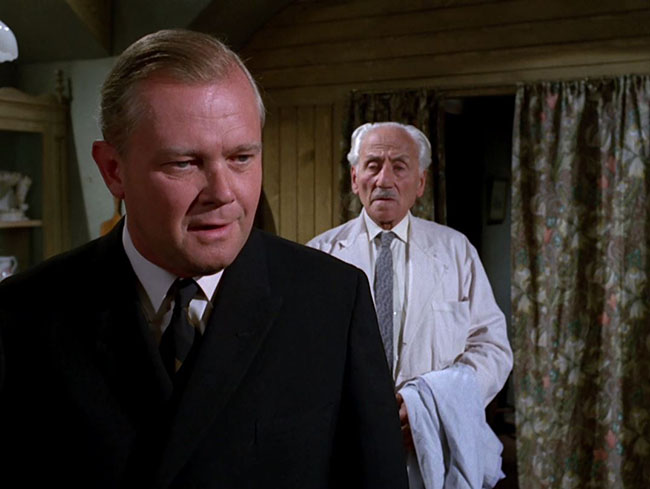
Nigel Stock and Hugo Schuster.
SEQUENCE
Although this is a very late episode, fourteenth in production order and thirteenth to air, when it came to arranging this sequence for Midnight Only I had to contend with the surprising number of late-season episodes that don’t take place in the Village. I’m making the effort to space them out. By placing this episode here, we can return to the Village for more traditional stories between this, the Western “Living in Harmony,” and the spy parody “The Girl Who Was Death.” It may also complement the last episode in this order, “A. B. and C.,” which presents a dream-view of No.6’s social life as an active agent; now we can contrast it with the reality. (They both feature similar parties; when No.6 and Janet dance, they might as well be at Madame Engadine’s.) That episode, like this one, also features a mad scientist device to manipulate minds, continuing the theme. But there aren’t many internal clues as to when to place this episode. It flashes back to “Free for All” so it must come after, and it would do a disservice to “Many Happy Returns” to place this one before it.
I also think it helps to have this, the weakest Prisoner episode, placed a good distance from the series’ end.
FISTICUFFS
Nigel Stock gets into an extraneous fight right before the episode’s conclusion, so he’s clearly been brought up to speed on the requirements for this particular television series.
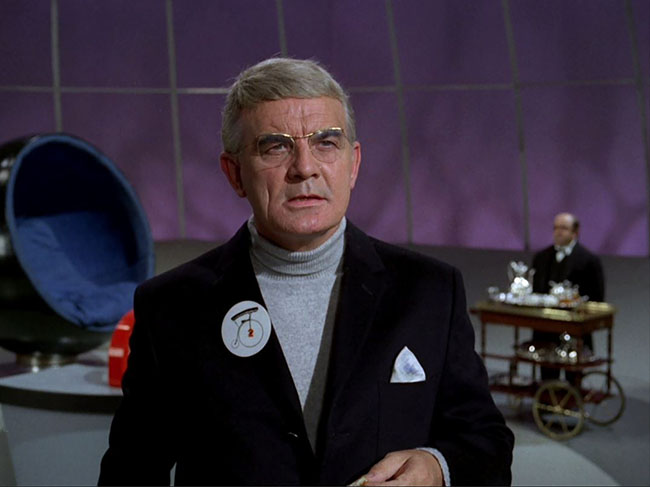
Clifford Evans as No.2.
METHODOLOGY
As in “The General,” no attempt is made to learn why No.6 resigned or to break his will. However, the stolen thought transference machine is revealed to be another tool in the Village’s arsenal, as well as the Amnesia Room (which must be located in the Convenient Plot Device wing of the Hospital), and both are used to manipulate No.6 into finding Seltzman for them.
THE OUTSIDE WORLD
We learn that No.6 was engaged to be married, that his code names were Schmidt in Germany, Duval in France, and ZM73 in the U.K. He knew Dr. Jacob Seltzman and worked alongside Sir Charles, Janet’s father. We also learn that he has been away in captivity for a full year.
Late in the episode, a letter is retrieved which No.6 had written to Seltzman before his captivity. Alert viewers may notice that the address is “Portmeirion Road.” The series would not reveal its now-famous shooting location until the finale; until then, it would be kept a secret, with only this winking clue.
WIN OR LOSE
No.6 is just a bystander in the climax. Seltzman cares for his own liberation, thank you very much. And while it’s a tidy conclusion, it makes No.6 seem all the more unheroic; at the end of the day, he was responsible for getting Seltzman captured and did nothing to help him get free.
So we’ll call this a win, but don’t give No.6 too much credit. Remember also that Village helicopters can be turned around (see: “Arrival“).
QUOTES
No.2: From time to time diplomatic swaps take place. Imagine the power we would have if the spies we returned had the mind of our own choosing. We could break the security of any nation.
No.2: Why make this stand now? You must have known what you were doing when you invented the wretched process.
Seltzman: Only people like you make it wretched.
UP NEXT: IT’S YOUR FUNERAL
